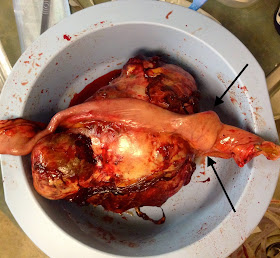Prevalence of inherited
disorders among mixed-breed and purebred dogs: 27,254 cases (1995–2010)
Thomas P. Bellumori, MS; Thomas R. Famula, PhD; Danika L. Bannasch, PhD, DVM; Janelle M. Belanger, MS; Anita M. Oberbauer, PhD. JAVMA, Vol 242, No. 11, June 1,
2013. Pg. 1549
Summary
In this study the authors analyzed
data from dogs seen at a university veterinary teaching hospital. (University
of California-Davis) The medical records were evaluated for dogs with one of 24
inherited conditions: different forms of neoplasia (hemangiosarcoma, lymphoma,
mast cell tumor, osteosarcoma), aortic stenosis, dilated cardiomyopathy,
hypertrophic cardiomyopathy, mitral valve dysplasia, patent ductus arteriosus,
ventricular septal defect, hyperadrenocorticism, hypoadrenocorticism,
hypothyroidism, elbow dysplasia, hip dysplasia, intervertebral disk disease,
patellar luxation, ruptured cranial cruciate ligament, atopy, bloat, cataracts,
epilepsy, lens luxation, and portosystemic shunt.
In 13 of these disorders
there was no difference in prevalence between purebred and mixed breed dogs.
Purebred dogs were more likely to have 10 of the inherited disorders, and mixed
breed dogs were more likely to have 1 of the disorders (ruptured cranial
cruciate ligament).
Disorders that were equally
prevalent in purebreds and mixed breed dogs were all the neoplasms
(hemangiosarcoma, lymphoma, mast cell tumor, and osteosarcoma), hypertrophic
cardiomyopathy, mitral valve dysplasia, patent ductus arteriosus, ventricular
septal defect, hip dysplasia, patellar luxation, hypoadrenocorticism,
hyperadrenocorticism, and lens luxation.
Inherited disorders that
were more common in purebred dogs were aortic stenosis, dilated cardiomyopathy,
hypothyroidism, elbow dysplasia, IVDD, atopy, bloat, cataracts, epilepsy and
portosystemic shunts. The only inherited disorder more common in mixed breed
dogs was ruptured cranial caudal ligament. As a sidelight, mixed breed dogs
were more commonly hit by a car than purebred dogs.
Commentary
The conventional wisdom is
that purebred dogs are more likely to be affected by inherited disorders. In
this study that was not true for all disorders, in fact less than half of the
ones evaluated. Only 10 of the 24 disorders studied were more commonly found in
purebred dogs, a surprising result of the research. Particularly surprising is
the equal prevalence of hip dysplasia, patellar luxation, and patent ductus
arteriosus between purebred and mixed breed dogs. These are all disorders that
we generally think of being associated with specific pure breeds (German
Shepherd-hip dyspasia, toy breeds such as miniature poodle for patellar
luxation, and poodle for PDA). Hip dysplasia was equally expressed between
purebred and mixed breed dogs in a previous study as well.
Dogs are thought to be
descendents from just a few lineages of wolves. The authors postulate that the
unexpected equal prevalence of many genetic disorders among dogs may be due to
this history of domestic dogs. If true, genetic mutations would be widespread
among all dog populations.
The findings of this study
suggest that inherited disorders vary in their prevalence according to the
disorder, not whether a dog is purebred or mixed breed. In other words, contrary
to what we might think, mixed breed dogs get genetic disorders too! Hopefully
studies like this will improve our understanding of genetic disorders in small
animals and help devise strategies to eliminate them from future populations.
Post your thoughts about this interesting study!



















